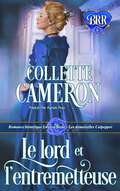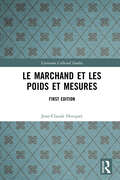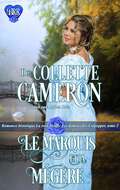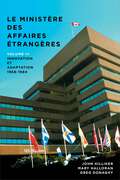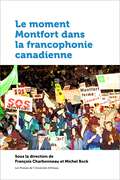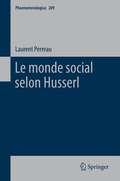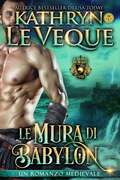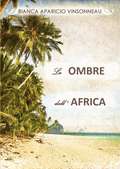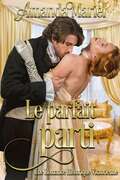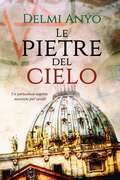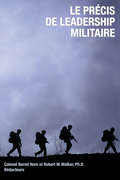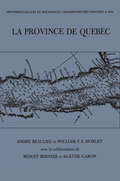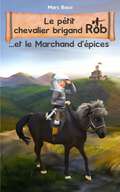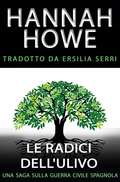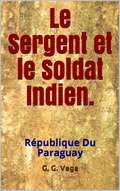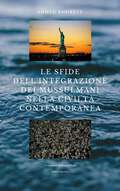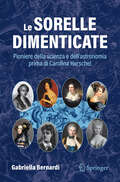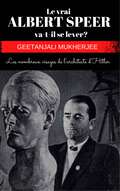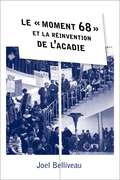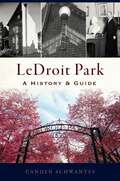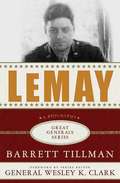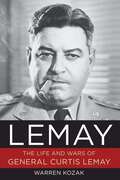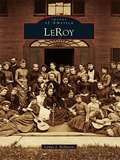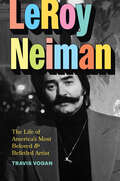- Table View
- List View
Le lord et l’entremetteuse (Les demoiselles Culpepper, tome 3 #3)
by Collette CameronUn rebelle devenu respectable. Une entremetteuse. Un couple qui n’est pas fait pour le bonheur. Lorsque le devoir impose à Alexander Hawksworth d’occuper le poste vacant de vicaire qu’un homme de sa famille occupe depuis des générations, il se résigne à une existence sobre. Bien qu’il soit dévoué à sa paroisse, les soirées et les fêtes lui manquent, surtout après l’arrivée à Londres de Brette Culpepper. Après avoir hérité inopinément d’un comté, il est déterminé à en faire sa comtesse, jusqu’à ce qu’il soit accusé du meurtre du précédent comte. Nouvellement arrivée dans la société, Brette adore le tourbillon de la société et les joutes verbales légèrement sensuelles avec le séduisant Alex Hawksworth. Elle se surprend à tomber amoureuse du charmant vicaire, mais lorsque la rumeur circule qu’elle est la petite-fille illégitime d’un pair, son monde bascule. Pour aggraver les choses, un tuteur nouvellement nommé apparaît, avec l’intention de la forcer à épouser un vieux dégénéré au lieu d’Alex. Le temps joue contre eux alors qu’Alex se bat pour laver son nom et délivrer la femme qu’il aime d’un destin impensable.
Le marchand et les poids et mesures (Variorum Collected Studies)
by Jean-Claude HocquetPublished in French in this Variorum volume, these chapters represent over twenty years of scholarship and publication. Many have been updated and translated from German and Italian into French for the first time. The chapters all deal with merchants, of whom the author is a world-renowned specialist, and their use of local weights and measures during the Middle Ages and the modern period. The reader is taken on a journey from the Carolingian Empire to pre-Columbian Mexico and post-colonial Java or Madagascar, from the measures of ancient Rome to the aluminium can of the 21st century. As the author has specialised in the history of salt and saltworks or of the sea, the book also makes room for salt springs, fish and fishing ports in northern Europe, and finally the scholarly investigation leads to the history of food, bread and cereals. The book expands on the earlier survey published in the Variorum series, which dealt mainly with Venice and salt, and was very well received by the educated public, who still wonder how people overcame the chaos of the old measures. The revolution of 1789 put an end to this situation by inventing the metre and the decimal system.
Le marin-citoyen: chroniques de la réserve navale du Canada, 1910–2010
by Richard H. Gimblett Michael L. HadleyCe livre commémoratif, produit à l’occasion du Centenaire de la Marine canadienne 1910–2010, traite d’une double citoyenneté particulière : celle des Canadiens exerçant le métier de la mer au service du Canada, tout en répondant aux devoirs de leurs activités civiles, chez eux, dans leur communauté. Les points de vue de ces citoyens marins à temps partiel, qui ont constitué la Réserve navale du Canada au cours des cent dernières années, offrent une autre histoire intéressante, utile et opportune de la Marine canadienne. La plupart des personnes ayant contribué à ce livre ont servi dans la Réserve navale du Canada, et tous sont des autorités respectées dans leur domaine. Lu isolément ou comme complément du livre Le service naval du Canada, 1910-2010 : Cent ans d’histoire (Dundurn, 2009), les lecteurs trouveront beaucoup de plaisir et d’information dans cette riche combinaison de textes, de photos et d’illustrations de personnes, de navires et d’aéronefs qui ont formé une fière institution nationale.
Le marquis et la mégère, tome 2 (Les demoiselles Culpepper #2)
by Collette CameronUn marquis tourmenté. Une mégère pleine de vie. Un ennemi mortel. Traînée à Londres pour la Saison, Blythe Culpepper est consternée d'apprendre que son tuteur a enrôlé le séduisant Lord Leventhorpe - le seul homme qu'elle déteste - pour l'aider à se lancer dans la société. Depuis leur première rencontre, les regards hostiles et les répliques acerbes abondent à chaque fois qu'ils se rencontrent. Pourtant, elle ne peut nier la façon dont son corps réagit lorsqu'il est à proximité. Tristan, l'austère et réservé marquis de Leventhorpe, évite habituellement les rencontres sociales. Alors pourquoi, en dépit de son bon sens, accepte-t-il d'aider son ami le plus proche à présenter les Culpepper à la bonne société ? Serait-ce parce qu'une demoiselle Culpepper particulièrement fascinante suscite plus que son intérêt ? Blythe le pousse à ses limites avec son esprit vif et sa langue acérée. Pourtant, il ne peut nier que cette beauté le captive comme aucune autre. Cependant, lorsqu'un ancien ennemi se manifeste et utilise Blythe pour régler de vieux comptes, Tristan doit décider si la restauration de l'honneur terni de sa famille - ce à quoi il travaille depuis des années - est plus importante que de gagner le cœur de la femme qu'il est venu aimer.
Le ministère des Affaires extérieures du Canada, Volume III: Innovation et adaptation, 1968−1984 (Politique et politiques publiques)
by Greg Donaghy John Hilliker Mary HalloranEn 1968, le ministère des Affaires extérieures du Canada est en état de siège. Terminées les décennies de croissance et de succès diplomatiques de l’après-guerre. La technologie et la libéralisation des échanges annoncent une ère de mondialisation. Devant les chocs pétroliers et l’inflation galopante, l’économie est en désarroi. La mondialisation s’invite au programme des affaires internationales en y ajoutant de nouveaux dossiers : droits de la personne, notamment ceux des femmes, énergie, science et technologie, environnement, révolutions et terrorisme à l’échelle mondiale. Le nouveau premier ministre, Pierre Trudeau, adhère à cette mutation. Ébranlé, le ministère peine d’abord à résister aux fortes pressions intérieures, politiques et économiques. Pendant les années 1970, toutefois, il parvient peu à peu à retrouver sa pertinence. Il se concentre sur une diplomatie d’ordre économique et invente des mécanismes administratifs qui lui permettent de concilier une perspective naturellement ouverte sur le monde avec les préoccupations particulières du gouvernement sur le front intérieur. Chemin faisant, les Affaires extérieures contribueront à la formulation de politiques innovantes au regard des principaux enjeux de l’époque, notamment les missions de maintien de la paix des Nations Unies, la décolonisation, le dialogue Nord-Sud, le Moyen-Orient, la crise des otages en Iran et les dangers incessants de la Guerre froide.Publié en français
Le moment Montfort dans la francophonie canadienne (Amérique française)
by Anne Gilbert Marcel Martel Marie-Claude Thifault Pierre Foucher François-Olivier Dorais Serge Miville Mariève Forest Madame Louise Bouchard Professeur Michel BockEn février 1997, le gouvernement ontarien annonce la fermeture de l’Hôpital Montfort, le seul hôpital universitaire francophone de la province. L’onde de choc est immédiate et donne naissance sans tarder à SOS Montfort, organisme militant voué à la sauvegarde d’une institution jugée essentielle à la survie de l’Ontario français. En résulte un impressionnant mouvement de solidarité qui braque les projecteurs sur la question des minorités francophones à l’échelle pancanadienne.Sous la direction de François Charbonneau et Michel Bock, Le moment Montfort dans la francophonie canadienne analyse sous plusieurs angles les enjeux et les retombées d’une crise d’envergure nationale. Il en offre une vue d’ensemble approfondie et inédite qui permet de renouveler notre compréhension de la condition sociopolitique des communautés francophones minoritaires au Canada.
Le monde social selon Husserl
by Laurent PerreauCette étude est consacrée à l'examen de la théorie du monde social qui se découvre dans la phénoménologie d'Edmund Husserl : est-elle à même de dire les phénomènes sociaux, sur quel mode et avec quels résultats ? Dans un premier moment, nous reconstituons le propos des deux « ontologies sociales » qui pensent le monde social en son essence et en ses essences : d'une part, l'ontologie de la région « monde social », subordonnée à la région de l'« esprit » et élaborée à partir d'une phénoménologie de la communication ; d'autre part, l'ontologie morphologique et eidétique des formes essentielles de communautés sociales. Dans un second moment, nous suivons l'élaboration d'une « sociologie transcendantale » qui reconsidère le rapport de la subjectivité transcendantale au monde social. Nous montrons comment les développements de la théorie de la personne dans la perspective de la phénoménologie génétique, qui semblent nous détourner de la considération de sa socialité, précisent en réalité le rapport du sujet personnel au monde social sous l'angle de sa « mienneté », de l'habitualité et de la familiarité d'une part, et dans la perspective d'une éthique sociale d'autre part. On établit enfin comment, autour de la Krisis, la théorie du monde de la vie fournit le cadre théorique d'une « sociologie transcendantale » qui se développe, sur le fond d'une anthropologie du monde commun, comme théorie de la générativité. De l'ontologie sociale à la sociologie transcendantale, cette recherche est conçue comme une investigation des ressources et des difficultés de la voie par l'ontologie d'accès à la réduction transcendantale, relativement à la question du « social ». Remarquable enquête menée sur l'expérience sociale du sujet, la phénoménologie husserlienne du monde social est susceptible d'intéresser le sociologue comme le philosophe qui s'interroge sur la nature du « social » en général.
Le mura di Babylon
by Kathryn Le VequeLe mura di Babylon di Kathryn le Veque Può l’amore prevalere su una battaglia per il trono? 1471 D.C. - Dieci anni dopo la battaglia di Towton, Sir Kenton le Bec (Il Leone del Nord) è al servizio di Warwick, “L’incoronatore”, come suo mastino. Non c’è cavaliere più efferato di Kenton le Bec nell'arsenale di Warwick, un guerriero forte e astuto. A Kenton è stato affidato il compito di mettere al sicuro il castello di Babylon, una fortezza che protegge una strada tra il Lancashire e lo Yorkshire. È un castello strategico ed è nelle mani dell’esercito di Edoardo. Quando arrivano Kenton e il suo esercito, cambia tutto. Eppure le cose non sono sempre ben chiare... Lady Nicola Aubrey-Thorne è la vedova di un grande sostenitore di Edoardo. Quando Kenton conquista la sua casa, il castello di Babylon, lei non gli offre nient’altro che resistenza e disprezzo. Kenton vede una donna bella e viziata, che lotta imperterrita contro di lui, eppure la scintilla dell’attrazione c’è. Sin dal principio. Man mano che Kenton viene a conoscenza degli oscuri segreti di Babylon, comincia a capire Lady Thorne e i suoi dispiaceri. E l’attrazione nei suoi confronti cresce a dismisura. Unisciti a Kenton e Nicola in un mondo di lealtà contrapposte e di attrazione che unisce. Le loro vite si intrecciano irrimediabilmente sebbene la loro lealtà nei confronti degli uomini che diventeranno re differisca. Poche persone sono in grado di vivere la passione e l’amore che provano l’uno per l'altra. È una situazione complessa e intricata, in cui bisogna prendere delle decisioni difficili se Kenton e Nicola vogliono restare insieme. Quando Kenton viene catturato dai soldati nemici, Nicola dovrà fare tutto ciò che è in suo potere per salvare l’uomo che una volta considerava suo nemico. Sarà troppo tardi?
Le ombre dell'Africa
by Bianca Aparicio VinsonneauAlla fine del XVIII secolo, nelle remote terre africane, il villaggio di Kofi viene selvaggiamente attaccato ed egli viene catturato e reso schiavo. Grazie a un’insperata svolta del destino, scampa alla morte e all’imbarco verso le piantagioni del Nuovo Mondo. In cambio, però, resta prigioniero nel castello di Cape Coast. Da lì, a rischio della sua stessa vita, riesce a mantenere una corrispondenza segreta con la donna che ama. Duecento anni dopo, l’antropologa Claudia Carpio viene inviata in quella che un tempo era nota come la Costa D’Oro. Mentre è occupata nella stesura dell’articolo più importante della sua carriera, le lettere misteriose arrivano nelle sue mani. Sconvolta dal loro brusco e sconcertante finale, si vede costretta a indagare nel torbido passato per scoprire cos’è successo a Kofi e perché ha smesso di scrivere. Non può sapere, però, che alcuni aspetti della storia non sono ancora conclusi e la coinvolgeranno in un gioco pericoloso. Un romanzo che ci trasporterà in luoghi esotici, in un intenso viaggio attraverso il tempo e le emozioni umane più profonde.
Le parfait parti (Une Romance Historique Victorienne)
by Amanda MarielLorsque Julia Honeyfield fut envoyée contre son gré dans une maison de passe, elle se sauva...Julia Honeyfield et sa mère sont dans une situation désespérée suite à l'abandon de son père. Sans argent et malade, la mère de Julia fait la seule chose à laquelle elle puisse penser en vue de sauver sa fille. Elle envoie Julia dans une maison close renommée de Londres. Lorsque Julia découvre la vérité, elle tente de s'échapper et se retrouve dans les bras de Charles, le Duc de Selkirk.Osera-t-elle lui faire confiance afin de la protéger ?Charles ne sait que faire de la demoiselle désemparée, mais il sait qu'il ne peut pas la laisser tomber. Quelque chose en Julia capte son intérêt et sans penser aux conséquences, il l’emmena dans sa résidence de campagne. Une fois sur place, il l'enrôle en tant que dame de compagnie de sa sœur et enrôle sa mère, la duchesse douairière de Selkirk, afin qu’elle devienne une vraie dame.Une nuit change tout...Lorsque Charles surprend Julia en train de danser seule au milieu de la nuit, il la prend dans ses bras. Débordants de désir, Julia et Charles se laissent aller à leur passion. Maintenant, tout ce qui leur est cher est en danger, surtout leurs propres destins.
Le pietre del cielo: Un pericoloso segreto nascosto per secoli
by Delmi AnyóPer gli amanti di romanzi come ''Il codice Da Vinci'' o "L'ultimo catone". Cosa si nasconde dietro la morte di una persona che credevi di conoscere? Un inquietante messaggio farà tremare il mondo di Julia, una giovane professoressa newyorkese, che la farà viaggiare in Europa. Misteriosi ancestrali e un pericoloso segreto nascosto nel corso dei secoli a qualsiasi costo, porteranno la protagonista a vivere un'emozionante avventura, attraverso le città più belle d'Europa. La Madrid di Carlo V, la Praga degli alchimisti, la Londra dei fondatori della Royal Society, la Parigi di Caterina de' Medici e tutto l'ermetismo dell'Archivio Vaticano, nonché l'antica Roma, faranno da sfondo a un pericoloso gioco contro il tempo, reale quanto il cielo stesso. Stampa, Blog e lettori di tutto il mondo pensano: "Le pietre del cielo" si diversifica per la sua trama attraente. Herald Miami: "Se hai un Indiana Jones nascosto in te e ti appassionano la storia, l'arte e il mistero, questo è il romanzo che fa per te".
Le precis de leadership militaire
by Robert W. Walker Colonel Bernd HornExprimé en toute simplicité, le leadership consiste à influencer les gens afin d'atteindre un quelconque objectif qui a de l'importance pour le chef, le groupe et l'organisation. C'est l'élément humain qui permet aux chefs de diriger, de motiver et d'inspirer les troupes, surtout en temps de crise, lorsque la situatioin est chaotique et complexe et que les directives, les déclarations officielles et les communiqués ne produisent guère d'effet sur les subalternes gelés, épuisés et tendus. Un bon leadership incite les subordonnés à aller au-delà du devoir d'obéissance et à se dévouer pour la réussite de la mission, d'une manière qui contribue à maximiser leur plein potentiel. Le Précis de leadership militaire est un manuel concret et compréhensif qui identifie, décrit, et explique tous les concepts, thèmes et idées qui s'appliquent directement ou indirectement au leadership militaire. Ce livre est un sommaire compréhensif qui a comme point de mire plusieurs sujets dont la cohésion, le commandement, l'intelligence culturelle, la discipline, la peur et la confiance. Ce précis offre une assistance à qui veut mieux comprendre la théorie et l'application du leadership militaire.
Le province de Quebec
by Agathe Garon W.F.E. Morley André Beaulieu Benôit BernierThere is no doubt that local and regional history, considered by many as a kind of minor historical study, has a pressing need for a systematic inventory of its resources. This collection shows the durability, the vividness, and the astonishing productivity of a sector of history which is the stronghold of the history-lover rather than the professional historian.The nature and content of each book determines its selection. For each book included, the compilers have weighed its contribution to local history and regional history rather than the style in which it is written--narrative, memoir, descriptive study, or novel. It is this criterion of selection that has permitted the retention of several general histories of a varied nature--Bouchette, Charlevoix, Nicholas Denys, La Potherie, Lescarbot, Hanotaux, Sulte, etc.-- where local and regional life takes on a major importance for reasons of order in history, method, or quite simply because local life is the principal object of the study itself. The editors have also retained certain works--those of George W. Brown, Arthur Buies, George M. Grant, Blodwen Davies, etc.--because they are primarily descriptive and contain numerous elements in which local history blends with the manners and customs of the inhabitants of certain regions.This bibliography is designed primarily for historiographers who have until now paid little attention to local, regional, or parochial history. It will also be invaluable for librarians who suffer from the numerous difficulties involved in the classification of such works. Since 1950, all works published in Canada are, by virtue of the book deposit law, provided to the National Library of Canada, and recorded in Canadiana.
Le pétit chevalier brigand Rob et le Marchand d'épices
by Marc BacoCe livre est intitulé le pétit chevalierbrigand Rob et le marchand d'épice.IL a six sous titres et contitués de plus de 16000 Mots à traduire en différentes langues
Le radici dell'ulivo: Una saga sulla guerra civile spagnola (L'Ulivo #1)
by Hannah HoweL'Ulivo - Saga sulla guerra civile spagnola Ambientato tra aprile 1937 e dicembre 1938, l'Ulivo è una mini-serie di cinque romanzi basati su eventi reali. Le sue storie - Radici, Rami, Foglie, Frutta e Fiori - raccontano la vita di Heini Hopkins, una giovane infermiera che vive in una zona impoverita del Galles del Sud, e Naomi Parker, un'autrice ricca con un background privilegiato. In Radici, Heini è a casa, in Galles, ad assistere la madre malata mentre Naomi partecipa alle feste di lancio del suo ultimo romanzo. La guerra civile in Spagna sembra un mondo lontano, fino a quando i fascisti bombardano e distruggono Guernica, uccidendo centinaia di uomini, donne e bambini. Il fidanzato di Heini, Deiniol Price, minatore di carbone, sente di doversi unire alla causa della Repubblica Spagnola e offrirsi volontario nelle Brigate Internazionali mentre l'amante di Naomi, il conte Nicolas Esteban, sogna la gloria, combattendo per i fascisti nell'aviazione. Le donne dovrebbero lasciare la sicurezza del Galles per i terribili campi di battaglia spagnoli? E se davvero decidessero di seguire i loro uomini, quale destino le attenderebbe?
Le sergent et le soldat indien: Histoires courtes du Paraguay
by G. G. VegaLe livre, appartient au groupe des Contes ou histoires courtes, idéales, pour une lecture rapide, divertissante, et vous y trouverez des informations tant historiques que géographiques, de la région du Chaco Boréal Paraguayen, au cœur de l’Amérique du Sud. Deux personnes entreprennent un long voyage, et sur le chemin, font l’expérience de situations étonnamment étranges, qui en fin de compte, sont des situations qui leur sauvent pratiquement la vie.
Le sfide dell'integrazione dei mussulmani nella civiltà contemporanea
by Ahmed SarireteVisto che il mondo si interessa sempre di più ai comportamenti dei mussulmani, e che gli sguardi diffidenti sono puntati all'origine della loro cultura, che è l'islam, questo saggio è destinato ai mussulmani in primo luogo, per donargli nuovi spunti di riflessione affinché possano riavere la propria visione del mondo alla luce delle sfide civilizzazionali da rilevarsi, e infine di permettergli di completare la loro integrazione e di giocare un vero ruolo nel concerto delle nazioni. Essendo poi destinato a chiunque sia interessato alla cultura e alla fede islamica in particolare al fine di chiarire e di invitarli ad una comprensione maggiore, e a cambiare l' atteggiamento di sospetto nei confronti dei popoli educati in questa cultura di fede.
Le sorelle dimenticate: Pioniere della scienza e dell'astronomia prima di Carolina Herschel
by Gabriella BernardiIspirato alle principali astronome menzionate nella poesia di Siv Cedering "Letter from Caroline Herschel" alle sue "sorelle perdute da tempo, dimenticate nei libri che registrano la nostra scienza", questo libro racconta la vita di venticinque scienziate, con un focus particolare su astronome e matematiche. Ogni biografia è presentata come un "fascicolo personale", che colloca la scienziata nel suo contesto storico, documenta le sue scoperte più significative, svela curiosità e raccoglie citazioni a lei dedicate. Le protagoniste sono figure emblematiche di un mondo a lungo trascurato, tra cui Ipazia di Alessandria, Ildegarda di Bingen, Elisabetta Hevelius e Maria Gaetana Agnesi. Il libro attraversa circa 4000 anni di storia, dall&’antica En HeduAnna, principessa accadica e una delle prime astronome riconosciute, fino all'alba dell&’astronomia moderna, con Caroline Herschel e Mary Somerville. Pensato per chiunque voglia scoprire le vicende di donne straordinarie che, dall'antichità al XIX secolo, hanno lasciato un segno indelebile nella scienza, spesso sfidando le convenzioni di un mondo dominato dagli uomini.
Le vrai ALBERT SPEER va-t-il se lever ?: Les nombreux visages de l'architecte d'Hitler
by Geetanjali MukherjeeAlbert Speer, l'architecte d'Hitler, a reçu plusieurs titres - "le bon nazi", "l'architecte d'Hitler", "le futur chancelier du Reich" et même "le seul accusé pénitent à Nuremberg". Il a présenté plusieurs visages au monde, mais lequel était authentique ? Speer a été largement impliqué dans le parti nazi, à la fois en tant qu'architecte d'Hitler et ministre de l'armement, et à travers ses contributions à la guerre illégale menée par le régime. Ainsi, la question se pose naturellement : Speer a-t-il reçu une punition adéquate ? Les événements qui ont précédé le procès de Nuremberg, et le procès lui-même, fournissent des indices pour répondre à ces questions : que pouvons-nous apprendre sur la personnalité de Speer à partir des preuves disponibles, et pourquoi est-ce important ? Dans les années qui ont suivi le procès, les biographes ont été fascinés par la vie de Speer et ont tenté de comprendre l'homme derrière l'énigme. La raison de la fascination tient autant à sa proximité avec Hitler et le régime qu'à ses actions à la fin de la guerre. Étaient-ils justifiables ? Le plus gros défaut de Speer était-il son ambition et son refus d'actes manifestement inhumains ? Ou Speer a-t-il réussi à enlever le tour de magie ultime pour convaincre le tribunal de son implication involontaire, tout en soutenant sans réserve le traitement réservé par les régimes nazis à ceux qu'ils opprimaient ?
Le « moment 68 » et la réinvention de l’Acadie: Le « moment 68 » et la réinvention de l’Acadie (Amérique française)
by Joel BelliveauLa distance et les barrières linguistiques n’ont pu empêcher le mouvement étudiant nord-américain de former une incarnation locale en terre acadienne, culminant dans une participation enthousiasme au « moment 1968 » planétaire, avec une saveur originale toutefois, qui changera profondément la culture politique de cette minorité linguistique.|Quatre notables acadiens reçus tels des chefs d’État par Charles de Gaulle au palais de l’Élysée. Plus de 2000 personnes qui manifestent dans les rues de Moncton scandant « on veut du français ! ». Une confrontation très médiatisée à l’hôtel de ville entre quatre jeunes résolus et un maire francophobe. Une tête de cochon déposée sur le seuil de sa maison en guise de protestation. L’occupation du plus grand pavillon de l’Université de Moncton par des étudiants armés de boyaux d’arrosage. Voilà quelques images fortes du « moment 68 » en Acadie, des images ancrées profondément dans la mémoire collective des Acadiens.Le présent ouvrage relate l’histoire du mouvement étudiant de Moncton, qui a été, toutes proportions gardées, l’un des plus importants au Canada au cours des années 1960. La dimension nationaliste de ce mouvement étant déjà relativement bien connue, cet ouvrage, appuyé sur des sources inexploitées, apporte une contribution importante à nos connaissances du « moment 68 », en l’ancrant dans l’histoire de la nouvelle gauche. Il permet ainsi de mieux comprendre la genèse et la nature de ce mouvement qui a conduit à un changement de paradigme politique en Acadie. Car, comme nous le rappelle l’auteur, les actions et les paroles des étudiants acadiens représentent, aussi, une incarnation locale de ce large mouvement qui marque l’histoire contemporaine et qui secoue le Québec comme le Canada, les États-Unis et l’Europe.|Quatre notables acadiens reçus tels des chefs d’État par Charles de Gaulle au palais de l’Élysée. Plus de 2000 personnes qui manifestent dans les rues de Moncton scandant « on veut du français ! ». Une confrontation très médiatisée à l’hôtel de ville entre quatre jeunes résolus et un maire francophobe. Une tête de cochon déposée sur le seuil de sa maison en guise de protestation. L’occupation du plus grand pavillon de l’Université de Moncton par des étudiants armés de boyaux d’arrosage. Voilà quelques images fortes du « moment 68 » en Acadie, des images ancrées profondément dans la mémoire collective des Acadiens.Le présent ouvrage relate l’histoire du mouvement étudiant de Moncton, qui a été, toutes proportions gardées, l’un des plus importants au Canada au cours des années 1960. La dimension nationaliste de ce mouvement étant déjà relativement bien connue, cet ouvrage, appuyé sur des sources inexploitées, apporte une contribution importante à nos connaissances du « moment 68 », en l’ancrant dans l’histoire de la nouvelle gauche. Il permet ainsi de mieux comprendre la genèse et la nature de ce mouvement qui a conduit à un changement de paradigme politique en Acadie. Car, comme nous le rappelle l’auteur, les actions et les paroles des étudiants acadiens représentent, aussi, une incarnation locale de ce large mouvement qui marque l’histoire contemporaine et qui secoue le Québec comme le Canada, les États-Unis et l’Europe. Publié en français
LeDroit Park: A History & Guide (History & Guide)
by Canden SchwantesBuilt as a gated, all-white community, in the 20th century LeDroit Park became the premier neighborhood of Washington, DC's Black elite.LeDroit Park's famed arch offers entry into a tree-lined neighborhood with unique architecture and a captivating history. Developed in 1873 by a Howard University trustee who refused to sell lots to Black Washingtonians, the neighborhood was designed to be both town and country, one of DC's earliest suburbs. Not long after the fences of this gated community were torn down, the demographics changed as members of the Black elite of Washington moved there. During the 20th century it was home to educators and activists, military men and artists, doctors and scientists - both white and Black, men and women.Local historian and guide Canden Schwantes leads you through this neighborhood, small in size but large in history, to discover the stories of the people who called LeDroit Park home.
LeMay: A Biography
by Barrett TillmanLeMay was a terrifying, complex, and brilliant general. In World War II, he ordered the firebombing of Tokyo and was in charge when Atomic bombs were dropped on Hiroshima and Nagasaki. He was responsible for tens of thousands of civilian deaths--a fact he liked to celebrate by smoking Cuban cigars. But LeMay was also the man who single-handedly transformed the American air force from a ramshackle team of poorly trained and badly equipped pilots into one of the fiercest and most efficient weapons of the war. Over the last decades, most U.S. military missions were carried out entirely through the employment of the Air Force; this is LeMay's legacy. Packed with breathtaking battles in the air and inspiring leadership tactics on the ground, LeMay will keep readers on their edge of their seats.
LeMay: The Life and Wars of General Curtis LeMay
by Warren KozakKozak's biography of U.S. Air Force General Curtis E. LeMay (1906-1990) won't convert those utterly convinced that he was a bomb-happy maniac. The more open-minded, however, will find in it a broader perspective on this controversial officer than we have had elsewhere. His outstanding competence as leader and organizer of strategic airpower in World War II and during the cold war is convincingly presented; so are his limitations in the Pentagon and his poor judgment in being George Wallace's running mate in 1968. Kozak suggests that LeMay was utterly dedicated to the mission of destroying his country's enemies and to the men under his command charged with carrying out that mission. This led to what can only be called a certain lack of the social graces and a good many of what might charitably be called misinterpretations of where LeMay's patriotism led him. A book that definitely belongs in aviation and modern military history collections.
LeRoy (Images of America)
by Lynne J. BelluscioLeRoy is best known as the "Birthplace of Jell-O," but few people know that in 1929 it had one of the finest private airports in the United States and was home to Amelia Earhart's airplane, the Friendship. In the 19th century, LeRoy was known for Igham University, one of the first colleges for women and the first to grant a four-year degree. First settled in 1797, LeRoy has produced patent medicines, salt, limestone, dynamite, plows, agricultural commodities, stoves, organs, insulators, and a myriad of other products. Located on the eastern edge of Genesee County and 30 miles southwest of Rochester, LeRoy originally depended on water power from the Oatka Creek and was soon serviced by several railroads. It was also a station on the Underground Railroad.
LeRoy Neiman: The Life of America’s Most Beloved and Belittled Artist
by Travis VoganThe untold story of an American hustler who upset the art world and became a pop culture icon, cutting a swath across twentieth-century history and culture. LeRoy Neiman—the cigar-smoking and mustachioed artist famous for his Playboy illustrations, sports paintings, and brash interviews—stood among the twentieth century’s most famous, wealthy, and polarizing artists. His stylish renderings of musicians, athletes, and sporting events captivated fans but baffled critics, who accused Neiman of debasing art with popular culture. Neiman cashed in on the controversy, and his extraordinary popularity challenged the norms of what art should be, where it belongs, and who should have access to it. The story of a Depression-era ragamuffin–turned–army chef–turned–celebrity artist, Neiman’s biography is a rollicking ride through twentieth-century American history, punctuated by encounters with the likes of Muhammad Ali, Frank Sinatra, Joe Namath, and Andy Warhol. In the whirlwind of his life, Neiman himself once remarked that even he didn’t know who he really was—but, he said, the fame and money that came his way made it all worth it. In this first biography of the captivating and infamous man, Travis Vogan hunts for the real Neiman amid the America that made him. .
